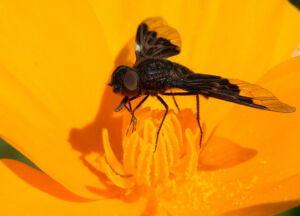Recommendations for effective insect conservation in nature protected areas based on a transdisciplinary project in Germany
Sebastian Köthe et al.
The aim of DINA is to test standardized monitoring of flying insects and to analyse factors that correlate with the drastic decline of insects in nature reserves.
The aim of DINA is to test a standardized monitoring of flying insects and to analyse factors that correlate with the drastic decline of insects in nature reserves. In three in-depth case studies, the ISOE team will bring different local groups of actors from agriculture, science, politics and nature conservation into a dialogue process with the aim to jointly develop feasible approaches to better protect biodiversity.
The integrative dialogue method to be developed must be able to deal constructively with tension-filled conflicts over land use and nature conservation. Because of the large number of different actors, cross-sectoral dynamics, diverse knowledge assessments and visions of the future, it is of great importance for the dialogue process that disciplinary and institutional boundaries are overcome. Based on a discourse field and conflict analysis, ISOE designs ‘Social Labs’ for this requirement which serve as an integrative instrument for a sustainable preparation of decisions in conflict-laden situations. To this end, ISOE draws on experience in transdisciplinary research. In particular, the tried and tested formats of stakeholder dialogues, integrative methods of knowledge generation, discourse field analyses and simulation games serve as a methodological kit for the Social Labs.
The Social Labs are conducted at three of the twenty-one monitoring sites investigated in DINA. Over a period of two years, a series of workshops and a continuous, transparent exchange of information will promote networking and understanding between different actors.
The current widespread loss of biological diversity traceably also includes conservation areas that are not accessible for human use. This was demonstrated both by the so-called “Krefeld Study” from 2017 and by the latest report of the World Biodiversity Council (IPBES). The scientific search for causes is proving difficult though due to the high complexity of interactions within nature and a comprehensive change of practices in agriculture and forestry. The search for ways to better protect biodiversity often fails due to differing perceptions of nature and the subsequently conflicting objectives of agriculture and nature conservation. So what is needed is an integrative process to point out these conflicting goals and moderate joint solutions.
The project “DINA – Diversity of Insects in Nature Reserves” is funded by the “Research Initiative for the Preservation of Biodiversity” of the Federal Ministry of Education and Research (BMBF).
Sebastian Köthe et al.
Sebastian Köthe et al.
Gerlind U. C. Lehmann et al.
Alexandra Lux et al.
Thomas Fickel, Alexandra Lux, Florian Dirk Schneider
What are the causes of biodiversity loss? How can we protect biodiversity in the future? How can we create a willingness for change?
Go to Topic Page


